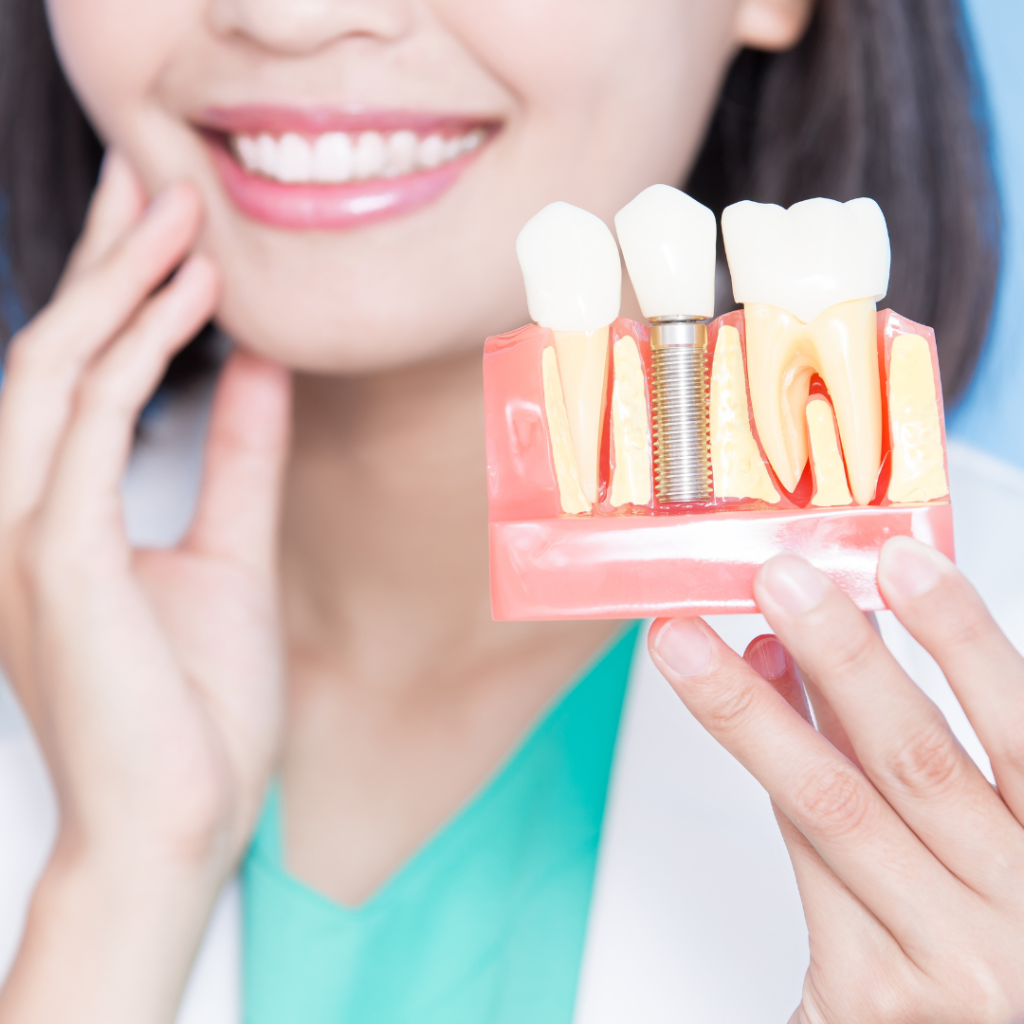Deep bite — modern treatment in Warsaw
Shortening of the lower third of the face, trauma to the gums during chewing, excessive load on the front teeth – typical consequences of a deep bite, which often goes unnoticed in adolescence. According to research, chronic dysfunction of the temporomandibular joint (TMJ) in 43% of cases is associated with the incorrect depth of overlap of the front teeth.
Correction of the bite at Astra Dent begins with an analysis of the vertical and sagittal ratio of the jaws, the position of the lower jaw at rest, during swallowing and speech.
Electromyography of the masticatory muscles, 3D facial scanning, lateral cephalometric radiography and digital modeling of the jaws are mandatory. The doctor takes into account the individual structure of the facial skeleton, the condition of the periodontium and joints in order to avoid relapse after treatment.
Without correction, the pathology progresses: the front teeth wear out quickly, cracks appear on the enamel, the balance of the neck muscles is disturbed, tension headaches occur. Astra Dent specialists perform therapy using individual orthodontic systems that take into account the growth and dynamics of occlusion — the contact between the teeth of the upper and lower jaw.
Why do patients choose Astra Dent Warsaw for the treatment and diagnosis of a deep bite?
Correction of a deep bite requires interdisciplinary interaction between an orthodontist, gnathologist and radiologist. Orthodontic intervention may be ineffective without assessing the position of the jaws, muscle balance and the ratio of articular surfaces. The stability of the result and the risk of relapse largely depend on the level of the medical institution, the experience of specialists and the quality of the equipment.
Advantages of treating a deep bite at Astra Dent:
- Experienced orthodontists. Doctors have been trained according to international protocols, possess methods of analyzing bite dynamics, work with digital articulators and scanners to simulate changes in real time.
- Modern systems for correcting bite. Patients can count on individual braces for deep bite, orthodontic mouthguards, devices with control of vertical growth and distalization, which are selected depending on the direction and degree of violation.
- Transparent pricing and convenient payment methods. All stages are calculated in advance, without hidden fees. Payment is possible by card, transfer or in installments.
- Comfortable environment and support in Ukrainian. Patients do not need to explain medical details in another language. Consultations, documents and information are provided in Ukrainian, without misunderstandings and stress.
Each clinical case is conducted according to a pre-compiled digital plan. Astra Dent specialists monitor the dynamics of treatment and make timely adjustments to the orthodontic scheme.
Why is it worth correcting the bite?
Improper occlusion of teeth is a factor that affects the functions of the dentofacial apparatus. The bite determines the efficiency of chewing, the quality of speech, breathing, the position of the jaws at rest, and the uniformity of the load on the joints and muscles. Ignoring the problem threatens the progression of pathological changes that complicate further treatment:
- Problems with chewing, speech, and breathing. When the bite is disturbed, the teeth contact unevenly, which reduces the efficiency of grinding food, distorts the pronunciation of sounds, and complicates nasal breathing.
- Impact on appearance and self-esteem. A shift of the lower jaw, shortening of the lower third of the face, retracted lips or their hypertonicity form an asymmetrical profile and disrupt the overall proportions of the face, which affects self-confidence.
- Enamel wear, joint pain, headache. Due to improper load distribution, the enamel in certain areas quickly thins, the chewing muscles become overstrained, and inflammation or blockage occurs in the TMJ. The patient complains of chronic headaches, especially in the temples and neck.
Treatment of a deep bite at Astra Dent in Warsaw begins with determining the source of the functional disorder. Thanks to digital scanners, teleradiography and muscle activity analysis, a full-fledged recovery strategy is selected that provides a predictable result.
Types of malocclusion
Orthodontic anomalies are classified by the type of contact disorder between the dental arches, the position of the jaws and the direction of deviation. Each type of occlusion has functional consequences, affects muscle load, breathing, pronunciation, and the ability to swallow normally. To determine the optimal treatment tactics, the specialist must know what type of violation he is dealing with:
- Deep bite. The upper incisors completely overlap the lower ones by more than 50%, which leads to enamel abrasion, load on the anterior dentition and gum injury during chewing.
- Open bite. When the jaws are closed, some of the teeth do not have contact – most often in the anterior area. It becomes difficult for the patient to bite off food, the pronunciation of certain sounds is disturbed, and nasal breathing is often replaced by oral breathing.
- Cross bite. The teeth of one jaw overlap the teeth of the opposite in a non-standard direction. The symmetry of the load is disturbed, unilateral hyperactivity of the masticatory muscles and facial asymmetry are formed.
- Distal or mesial bite. In the first case, the lower jaw is too far back, and in the second, it protrudes forward. Changes affect the profile and function of the joint, provoking clicking, limited mobility and headaches.
- Crowding of teeth or large gaps. Violation of the density of the placement of teeth in one or both rows complicates hygiene, contributes to the development of caries and gum disease. Excessive gaps disrupt occlusal contacts and cause excessive load on individual teeth.
Each type of bite disturbance is diagnosed by the Astra Dent team using 3D scanning, analysis of occlusal planes, computer modeling and teleradiography in projections. Due to the comprehensive approach, not only the type of anomaly is determined, but also the cause of the disorders – from improper jaw growth to muscle tone imbalance.
Symptoms of a deep bite
At first glance, a deep bite seems to be only an aesthetic defect, but the impact of the anomaly goes beyond appearance. Due to excessive overlap of the lower teeth, the work of the temporomandibular joint is disrupted, the enamel is worn away, the proportions of the face change and functional complications arise, which increase with age. Therefore, it is important to recognize the characteristic signs of pathology in time:
- Teeth abrasion. Due to constant pressure in the anterior part, the enamel is worn away unevenly, microcracks appear, sensitivity to temperature stimuli increases and it becomes difficult to restore the shape of the tooth during restoration.
- Pain in the temporomandibular joint. When the jaws are closed incorrectly, the load is transferred to the articular disc, there is a clicking, crunching or aching pain in the area near the ear, which can radiate to the neck and temples.
- Facial changes. A decrease in the vertical size of the lower third of the face, a deepening of the chin, lip displacement and tension in the chewing muscles form an unnatural facial expression, especially in profile.
Astra Dent doctors consider the symptoms in a complex, taking into account data from electromyography and X-ray imaging. Thanks to this, the underlying causes of the pathology are revealed, which often remain unnoticed during a superficial examination.
Causes of occurrence
The formation of a deep bite occurs gradually and begins in childhood. If deviations are not noticed in the early stages, the body's compensatory mechanisms will begin to mask the problem until it leads to functional disorders. Successful treatment involves taking into account the root causes that formed the pathological occlusion:
Genetic reasons. Hereditary features of jaw growth, the depth of the basal bone bed, vertical facial type or muscle hypertonus are transmitted at the gene level and form a tendency to excessive overlapping of teeth.
Delayed teething. If permanent teeth appear late, the occlusion is not stabilized during the critical period of development. As a result, the balance between vertical jaw growth and bite closure is disrupted, which subsequently provokes the depth of overlap.
Loss of milk teeth. Premature removal or loss of milk incisors and molars disrupts the direction of growth of permanent teeth. As a result, the jaws shift and the contact between the teeth is formed incorrectly.
Astra Dent specialists use comprehensive diagnostics to establish the exact origin of the pathology. Data from orthopantomogram, digital bite analysis and functional testing allow us to distinguish hereditary factors from acquired ones, which is important for choosing a treatment strategy.
What is dangerous about a deep bite?
In the initial stages, a deep bite does not cause discomfort, but over time it provokes a number of functional disorders that affect the teeth, the work of muscles, joints and the speech apparatus. If you do not intervene in time, the consequences become systemic, reducing the quality of life:
- Risk of bite disorder. A deep overlap disrupts the balance between the jaws and over time leads to secondary anomalies – displacement of the dental arches, crossbite.
- Diction disorders. Due to the atypical position of the front teeth, the articulation of sounds is disturbed, especially s, sh, h, z. In children, this manifests itself as interdental lisp, and in adults – as a complication of pronunciation during public speaking.
- Headache. Excessive tension of the chewing and cervical muscles due to impaired occlusion causes tension headaches, most often in the area of the temples, the back of the head and the upper part of the neck.
- Bruxism. With a deep bite, nighttime teeth grinding develops. This is the body's protective reaction to improper closure, which over time leads to enamel abrasion, cracks, joint overload and even fractures of restorations.
All risks are assessed by Astra Dent specialists during the initial functional analysis. The orthodontist works in tandem with a gnathologist and uses digital tools to record minimal deviations in the work of the temporomandibular joint and muscle coordination.
Treatment of a deep bite
Bite correction is a step-by-step process that requires moving teeth, influencing the position of the jaws, stabilizing muscle tone and controlling growth in adolescence. The treatment plan is drawn up on the basis of digital diagnostics, and the approach itself depends on the patient's age, the depth of the overlap and concomitant disorders.
Stages of orthodontic correction
Each case requires an individual selection of a system that would provide control over the teeth and the position of the jaws in three-dimensional space:
- Braces. Fixed systems allow us to control the inclination of the teeth, correct the vertical position of the frontal region, and influence the intermaxillary relationships through the use of arches and ligature force.
- Aligners. Transparent mouthguards with digital movement planning help control each stage of bite correction. In case of deep overlap, mouthguards with special protrusions are used to lift the bite.
- Additional devices. In some cases, vertical control devices, microimplants for anchoring or functional trailers are used, which affect the direction of jaw growth.
- Retention. After the active stage of correction, removable or non-removable retainers are installed, which stabilize the achieved position of the teeth and jaws, preventing relapse.
Fixation of the result is a mandatory part of the treatment process. It is monitored using periodic scans and photo protocols, which allow even minor changes to be tracked at any stage of therapy.
Options for children and adults
The approach to treating patients of different ages is significantly different. In childhood, it is possible to influence the growth and formation of the jaws, while in adults, correction is based on moving the teeth and restoring occlusal balance:
- Children. Devices are used that direct the growth of the jaws, block bad habits and normalize chewing function. During the period of mixed bite, removable structures or functional plates are used to correct the direction of growth.
- Teenagers. Fixed systems or aligners are prescribed, taking into account the growth phases. Preference is given to methods that allow influencing the intermaxillary relationships without surgery.
- Adults. Treatment is based on changing the position of the teeth, compensating for imbalances in the joints and muscles. In complex cases, it is possible to combine orthodontics with gnathology or orthognathic surgery.
- Patients with joint pathology. Treatment involves functional testing, digital occlusal diagnostics and coordination with a gnathologist, which allows you to avoid aggravation of TMJ dysfunction during tooth movement.
Age differentiation is necessary to choose the right tactics. Astra Dent takes into account both the biological age of the jaws and the general condition of the bone tissue, the presence of concomitant diseases and the patient's psycho-emotional readiness to cooperate.
How is deep bite treatment performed at Astra Dent Warsaw?
Treatment at Astra Dent is based on evidence-based orthodontics and digital protocols, thanks to which doctors can predict the results even before the intervention. Correction of the bite occurs in several stages – from the initial consultation to stabilization of the result.
Primary diagnostics and functional analysis
The first visit lasts from 40 to 60 minutes. During this time, the doctor collects a complete clinical picture, assesses the bite, the condition of the soft tissues, the position of the jaws at rest and during movement:
- a 3D scan of the teeth and jaws is performed;
- a photofixation of the face and bite in different projections is performed;
- a panoramic image and a lateral tel-rectogram (TRG) are taken;
- if necessary, electromyography or occlusal analysis is performed.
The data determine the form of the pathology, the functional status of the chewing apparatus, and the potential risks of treatment.
Drawing up an individual treatment plan
After analyzing the diagnostic information, the doctor forms a step-by-step action plan. Each stage is agreed with the patient:
- the plan is drawn up in digital format, with visualization of changes in the bite;
- all possible alternatives are explained: type of systems, terms, hygiene features;
- if there are concomitant problems (periodontitis, TMJ dysfunction, need for implantation), related specialists are involved.
The patient receives not general advice, but a clear route with control visits and stages of correction.
Selection of an orthodontic system
The choice depends on the type and severity of the bite, aesthetic wishes and age of the patient:
- Metal braces. The most effective for complex cases. They provide complete control over the movement of teeth, are used with significant overlap.
- Ceramic braces. Less noticeable than metal structures. Often used in combination with aesthetic arches.
- Lingual braces. Attached to the inner surface of the teeth, completely invisible from the outside. Requires careful hygiene and greater adaptation.
- Invisalign, Spark aligners. Transparent mouthguards are made individually. Used for mild and moderate deep bite.
Astra Dent offers combined treatment, when different systems are used at separate stages or jaws.
Treatment control and stabilization of the result
After installing the system, the patient visits the dental office every 4-8 weeks to control tooth movement, change the arches or receive new aligners:
- each visit is accompanied by photofixation and comparison with the plan;
- the scheme is corrected (especially in case of asymmetries or delay of individual segments);
- upon completion of the active phase, a retention system is installed – mouthguards or fixed retainers.
Control after removing the braces lasts at least a year. This approach reduces the risk of relapse.
How to make an appointment at Astra Dent Warsaw?
Timely diagnosis of a deep bite allows you to avoid complications and start treatment at a favorable stage. The reception at Astra Dent in Warsaw is conducted by experienced orthodontists who work with digital technologies, modern bite correction systems and complex clinical cases.
You can make an appointment in a way convenient for you:
- phone: +48 533 599 552;
- e-mail: info@astradent.pl;
- online application: the form is available on the website astradent.pl.
The appointment takes place without a long wait. You choose a convenient time yourself, and the dental office administration confirms the visit without delay. This is the first step towards a correct bite, stable joint function and self-confidence.

Last update:
17 July 2025, 20:45





















